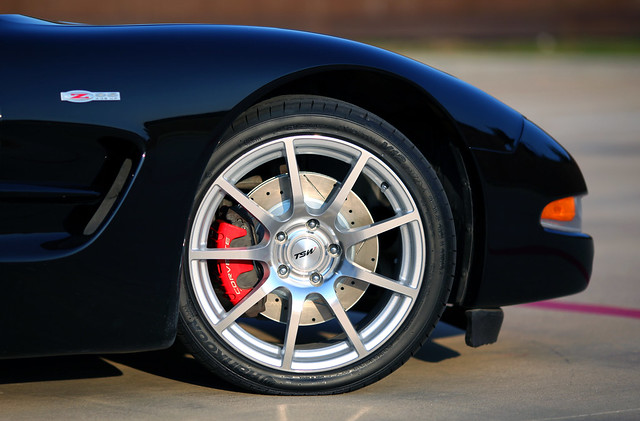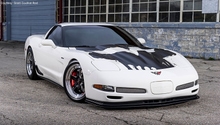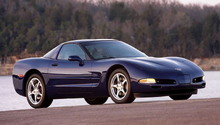C5 Corvette: General Specifications and Information
This article provides information about the C5, including transmission and engine specifications as well as common issues.
This article applies to the C5 Corvette (1997-2004).
The C5 Corvette was designed by Joe Cafaro and manufactured by Chevrolet in the legendary Corvette factory in Bowling Green, Kentucky from 1997 to 2004. A byproduct of a long production run, it was manufactured in a variety of body styles. The C5 was available in 2-door coupe, 2-door convertible, and 2-door hardtop. An ultra-fast Z06 model and Indianapolis 500 and LeMans commemorative editions were also produced.

So how exactly can you tell what kind a Corvette is just by looking at it? While most Corvettes look alike, there are different features that set them apart, and even with similar looks, they can wildly vary in engine, transmission, and suspension specs. Here is a specification breakdown that should get you up to speed in Corvette lingo.
General Specifications
Body Styles
The C5 convertible is equipped with a retractable soft top and an optional hardtop. It epitomizes the fun and flair that the Corvette is known for.

The C5 coupe offers the quietness and reliability of a hardtop as well as the playfulness of a convertible via removable glass or aluminum roof panels.

The Corvette hardtop is the iconic Corvette. The solid roof setup offers the most stability and rigidity to make sure the C5 performs on the track.

The Z06 is the one and only king of the Nurburgring. When it comes to getting the most bang for your buck, the Z06 outperforms world-class exotics. A Z06 can quickly be distinguished by the rear brake-cooling vents located in front of the rear wheel, along with special badges and front lip air intakes.
Engine Performance
The C5 Corvette is a stunning car to look at, but it is even more fulfilling to drive. The heart and soul of the Corvette lies in its V8 engine. Below are the engine specs for the different Corvette LS engines used on the C5.
Note: LS1 Engine is used in all C5 variations. LS6 Engine is used on the Z06 model only.
- Power: LS1 Engine, 350 horsepower at 5200 RPM / LS6, 385-405* horsepower at 6000 RPM (*2002+ models)
- Torque: LS1 Manual: 375 lb./ft, Automatic: 360 lb./ft / LS6, 385-400* lb./ft (2002+ models)
- Displacement: LS1 and LS6 5.7 Liter V8 346 cubic inch
- Bore x stroke (in.): LS1 and LS6 3.90 x 3.62
- Block: Cast Aluminum with titanium bolts
- Oiling: Traditional wet sump (LS1), Drysump (LS6)
- Compression ratio: 10.1:1
- Recommended fuel: 91 Octane
- Maximum recommended RPM: LS1- 6000RPM; LS6- 6500 RPM
- Estimated Fuel Economy (MPG): 19 / 28 / 23 (manual coupe and convertible), 18 / 25 / 21 (automatic coupe and convertible)

Transmission Specifications
As noted on the engine specs, the C5 with LS1 engine was outfitted with an automatic and manual transmission. The Z06 with LS6 engine was only fitted with a 6-speed manual.
C5 LS1 coupe and convertible:
- Equipped standard with a 4-speed (plus reverse), automatic Hydra-Matic 4L60-E
- Optional: 6-speed manual Tremec T56 (MM6)
C5 LS6 Corvette Z06:
- Equipped standard with a 6-speed manual Tremec T56 (M12)

Suspension Specifications
There is a saying that goes, "Power is nothing without control." The Corvette is known for being an agile fighter in the corners and a monster on high-speed straights, but to make that happen requires the right suspension, wheel, and tire setup. The front and rear suspension specs for the C5 and Z06 are as follows:
- Short/long arm (SLA) double wishbone
- Cast aluminum upper & lower control arms
- Transverse-mounted composite leaf spring
- Monotube shock absorbers
Wheels
For the C5:
- Cast aluminum; front 17" x 8.5", rear 18" x 9.5"
- Goodyear Eagle F1 GS Extended Mobility; front P245/45ZR17, rear P275/40ZR18
- Cast-spun aluminum; front 17" x 9.5", rear 18" x 10.5"
- Goodyear Eagle F1 SC Asymmetric Tread; front P265/40ZR17, rear P295/35ZR18

Common Issues
According to CorvetteForum.com, these are the most common problems with the C5 Corvette. They range from minor annoyances to downright dangerous problems. See the related links below for more information on these issues if you feel your vehicle was affected.
| Issue | Description |
|---|---|
| Rocking seat | Sliders for the seats will not latch tightly or lock in place, causing the seat to flex under duress or hard cornering. |
| Stuck clutch pedal | Clutch fluid is easily contaminated in the slave and master cylinders of C5 Corvettes, and regular servicing of the fluid is required for proper operation. |
| Fuel sender malfunction | The fuel level sending unit can be corroded by contaminants found in modern gasoline, and over time, this causes the fuel gauge to give incorrect readings. Forum users have reported that the best defense to this issue are fuel injection treatments like "Techron." |
| Oil pressure sender | The sending unit is difficult to access and will wear out with time. When people attempt to replace it, they often over-tighten the sender (15 lb./ft.), causing it to break again shortly after. |
| Wobbling harmonic balancer | The balancer material (metal and rubber) wears with age around the mounting bolt, causing it to spin loosely. The balancer must be replaced; aftermarket options are available. |
| Column lock | Likely the most prominent issue with the C5 is the intermittent instances in which the steering column will lock, preventing drivers from starting or moving the vehicle. There is an active recall with GM for this item. |
Related Discussions
- Rocking Seat Fix - CorvetteForum.com
- Sticky Clutch Pedal - CorvetteForum.com
- Fuel Sending Issue - CorvetteForum.com
- Oil Pressure Sender - CorvetteForum.com
- Wobbly Harmonic Balancer - CorvetteForum.com
- Steering Column Lock Ultimate Thread - CorvetteForum.com






